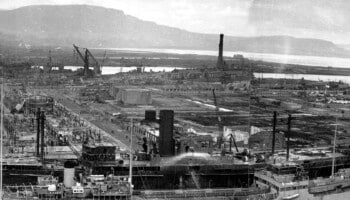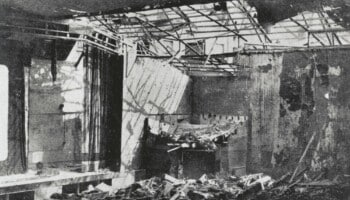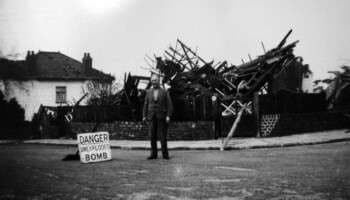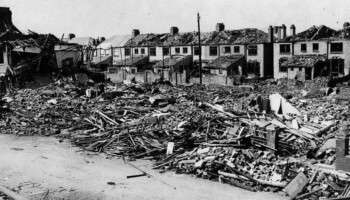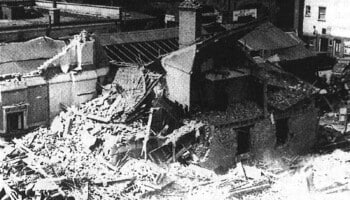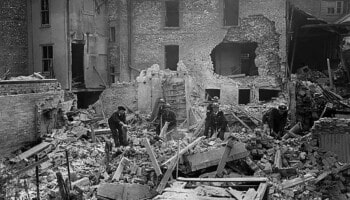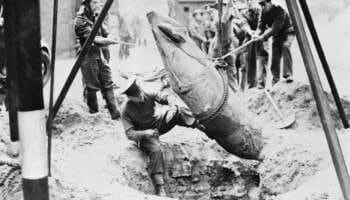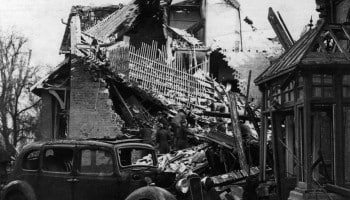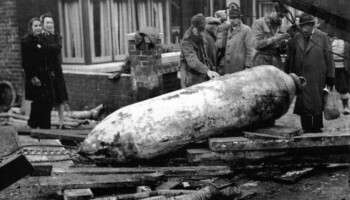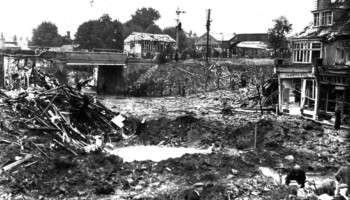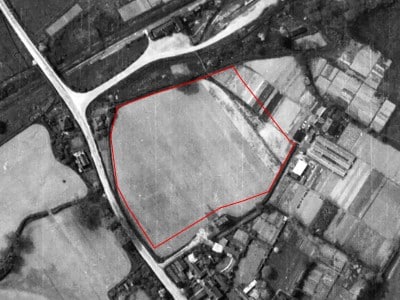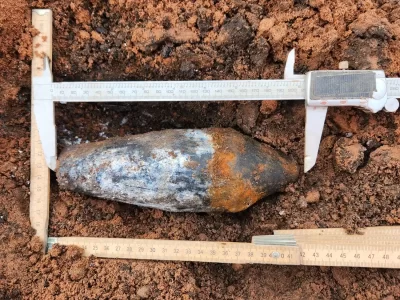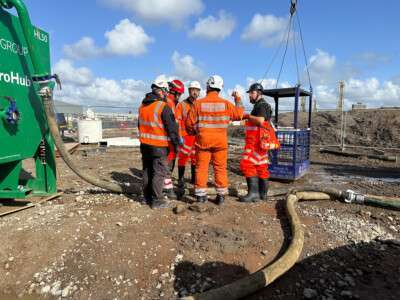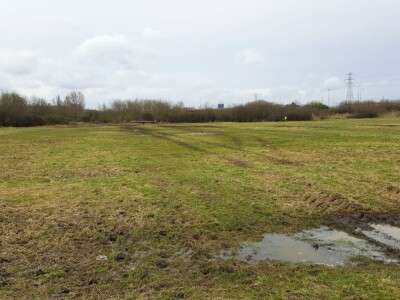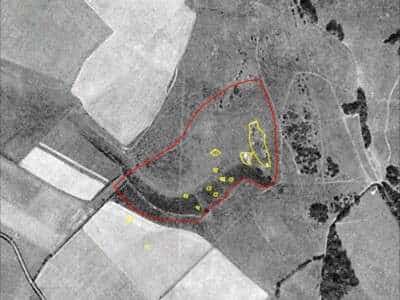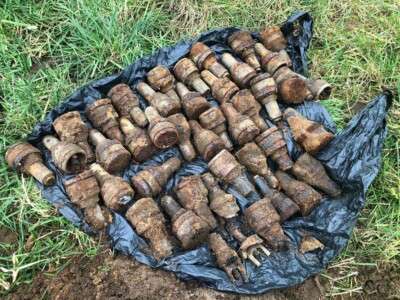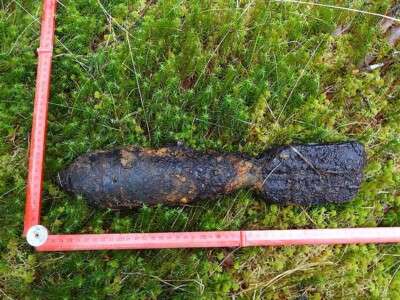Home » UXO Services »
What is a UXO Risk Assessment?
A UXO Risk Assessment is a site-specific report that examines the potential risk posed by explosive ordnance to site investigations and intrusive works.
For the majority of construction projects and offshore developments across the UK, the risk of encountering UXO will be minimal – but in many cases the impact of past military activity on or near your site may not be obvious.
In the UK, UXO broadly derives from two sources:
- Air-delivered weaponry from WWI and WWII.
- Contamination related to current and historic military land use.
It is recommended that all construction and site investigation projects consider the possibility of encountering UXO as early as possible in the project plan.
1st Line Defence provide two types of UXO Risk Assessment: stage 1 is a Preliminary UXO Risk Assessment and a stage 2 Detailed UXO Risk Assessment.
If a UXO risk is identified from the assessment, mitigation measures can be put in place to manage the risk and ensure ground workers/assets are safe and secure.
What is the difference between a Preliminary and Detailed UXO Risk Assessment?
Preliminary UXO Risk Assessment: A basic pre-screening desk study report that examines whether there is history of bombing or military activity on your project, and determines whether there is any need for further research or action.
Detailed UXO Risk Assessment: If any potential risk or need for further research is identified during the Preliminary stage, we would recommend a Detailed UXO Risk Assessment is commissioned – which is a in-depth desktop survey and comprehensive report which fully examines the history of a project.
Click on the buttons below to find out more about the different UXO Risk Assessments we offer or visit our UXO Risk Maps page which provides guidance about the risks associated with construction planning – and the risk mapping procedure we recommend.
Looking for more information about Preliminary UXO Risk Assessments & Detailed UXO Risk Assessments?
Preliminary UXO Risk Assessment
Detailed UXO Risk Assessment
UXO City Guides
The risk of encountering UXO as a result of WWII is not limited solely to London. Through a series of UXO City Guides, we explore the potential of UXO contamination at different locations across the UK.
“1st Line Defence have now undertaken a number of pre-acquisition desk top studies for us. They have proven to be informative and instructive as to site conditions and the likely risks associated. We have also employed them on site to undertake site investigation of piling locations. They undertook these works efficiently, on programme and competitively. On their site performance to date, 1st Line Defence will continue to be our choice for UXO reports and site works.“
Technical Executive, Crest Nicholson London
Explore our Case Studies
Frequently Asked Questions
Browse the most commonly asked UXO Risk Assessment questions or contact us if you have a specific enquiry
The majority of UXO encountered in the UK is not actually of German origin. During WWII, over 4,000,000 hectares of UK land were in use with British and Allied armed forces. The Construction Industry Research and Information Association (CIRIA) estimates that approximately 20% of the UK's land mass has seen some form of military activity at some stage. As of 2017, the MOD’s training estate covered around 364,000 hectares. For these reasons, the only way to be sure of identifying all UXO risks on your site is to carry out a UXO Risk Assessment.
The majority of UXO encountered in the UK is not actually of German origin. During WWII, over 4,000,000 hectares of UK land were in use with British and Allied armed forces. The Construction Industry Research and Information Association (CIRIA) estimates that approximately 20% of the UK's land mass has seen some form of military activity at some stage. As of 2017, the MOD’s training estate covered around 364,000 hectares. For these reasons, the only way to be sure of identifying all UXO risks on your site is to carry out a UXO Risk Assessment.
It cannot be ruled out completely as your site could still have been bombed from opportunistic ‘tip and run’ raids that were common during WWII. Bombing overspill from raids on other major targets nearby may have also affected your site, and we would always recommend to get a UXO Risk Assessment first.
It cannot be ruled out completely as your site could still have been bombed from opportunistic ‘tip and run’ raids that were common during WWII. Bombing overspill from raids on other major targets nearby may have also affected your site, and we would always recommend to get a UXO Risk Assessment first.
Unfortunately not. They are often incomplete and should be used in conjunction with other records wherever possible. For example combining information from WWII-era aerial photography, bomb census mapping and written bomb incident records would give a more accurate indication of where a bomb fell than one of these sources alone. It is imperative that historical research for UXO Risk Assessments is thorough and that all available resources are utilised.
Unfortunately not. They are often incomplete and should be used in conjunction with other records wherever possible. For example combining information from WWII-era aerial photography, bomb census mapping and written bomb incident records would give a more accurate indication of where a bomb fell than one of these sources alone. It is imperative that historical research for UXO Risk Assessments is thorough and that all available resources are utilised.
You may be putting people at risk. Although UXO risk in the UK is generally considered ‘low probability’, it is ‘high consequence’. Health and safety legislation requires you to consider foreseeable risks such as this. Even the unexpected discovery of an item of UXO can incur expensive downtime, delays and cost overruns. Being aware of the potential risk of UXO on your site is essential. You do not have to conduct a comprehensive UXO Survey for every site, but the risk of UXO should be considered and a Preliminary or Detailed UXO Risk Assessment undertaken.
You may be putting people at risk. Although UXO risk in the UK is generally considered ‘low probability’, it is ‘high consequence’. Health and safety legislation requires you to consider foreseeable risks such as this. Even the unexpected discovery of an item of UXO can incur expensive downtime, delays and cost overruns. Being aware of the potential risk of UXO on your site is essential. You do not have to conduct a comprehensive UXO Survey for every site, but the risk of UXO should be considered and a Preliminary or Detailed UXO Risk Assessment undertaken.
The type of information we use can depend on factors such as where the site is located – but for a Detailed Risk Assessment, as a minimum we would use the following where available:
- Previous military use, location history and land use.
- Reports and records of air-delivered bombs (WWI & WWII).
- Frequency of access, damage, ground cover.
- Consideration of any mitigating factors.
- Extent and nature of proposed intrusive works.
- Local and national archives.
- Historical and bomb census and damage mapping.
- High-resolution WWII-era aerial photography.
- Written ARP bomb incident reports.
- Luftwaffe target information.
The type of information we use can depend on factors such as where the site is located – but for a Detailed Risk Assessment, as a minimum we would use the following where available:
- Previous military use, location history and land use.
- Reports and records of air-delivered bombs (WWI & WWII).
- Frequency of access, damage, ground cover.
- Consideration of any mitigating factors.
- Extent and nature of proposed intrusive works.
- Local and national archives.
- Historical and bomb census and damage mapping.
- High-resolution WWII-era aerial photography.
- Written ARP bomb incident reports.
- Luftwaffe target information.
If a Preliminary UXO Risk Assessment has identified a potential UXO risk on your site, we would recommend that a Detailed UXO Risk Assessment is commissioned – which is an in-depth desktop study which fully investigates the risk of UXO being present. If the Detailed UXO Risk Assessment has identified a threat from UXO and it has been classified as medium or high, we would recommend a risk mitigation plan is created and implemented to reduce the risk to as low as reasonably practicable (ALARP).
If a Preliminary UXO Risk Assessment has identified a potential UXO risk on your site, we would recommend that a Detailed UXO Risk Assessment is commissioned – which is an in-depth desktop study which fully investigates the risk of UXO being present. If the Detailed UXO Risk Assessment has identified a threat from UXO and it has been classified as medium or high, we would recommend a risk mitigation plan is created and implemented to reduce the risk to as low as reasonably practicable (ALARP).
Yes. It was quite common for the trajectory of unexploded bombs (UXBs) in the ground to veer off to one side – so that the final position of the bomb is at a lateral offset from point of entry – possibly beneath an adjacent structure. This is known as a ‘J-curve’ effect. A UXB may also have fallen unnoticed on an area which was subsequently developed post-war – meaning that buildings could potentially have been constructed on top of a UXB.
There is no UK law that requires the construction industry to undertake a UXO Risk Assessment before starting ground works. However, the Health and Safety at Work Act 1974 and the Construction (Design and Management) Regulations 2015 require consideration of foreseeable risks – and UXO is a potential risk. The Construction Industry Research and Information Association (CIRIA) have produced a guidance report which is called – CIRIA C681: Unexploded ordnance (UXO) A guide for the construction industry. The report highlights best practices for the management of risks associated with UXO and covers what to expect from a UXO Specialist. Find out more about this guidance on our Resources page here.
Some construction companies still forget to consider or simply do not recognise the potential risk of UXO being present on their site. There are many recent examples of unexploded bombs (UXBs) being found on construction sites where no UXO Risk Assessment or mitigation work was undertaken – but where the accidental detonation of the item would have been catastrophic. The more responsible companies will assess / investigate UXO risk on their site as standard practice.
It is important not to get complacent about the risk of UXO in construction sites across UK. Some cities, especially large cities like London, Liverpool and Birmingham, and coastal cities like Southampton were heavily targeted by the German Luftwaffe during WWII – and are prone to have more UXO risk due to more bombs being deployed.
Some of the most densely bombed cities in the UK are listed below:
- UXO risk in Belfast
- UXO risk in Bath
- UXO risk in Birmingham
- UXO risk in Brighton
- UXO risk in Bristol
- UXO risk in Canterbury
- UXO risk in Cardiff
- UXO risk in Chelmsford
- UXO risk in Clydebank
- UXO risk in Coventry
- UXO risk in Dover
- UXO risk in Exeter
- UXO risk in Great Yarmouth
- UXO risk in Hull
- UXO risk in Liverpool
- UXO risk in London
- UXO risk in Manchester
- UXO risk in Newcastle
- UXO risk in Norwich
- UXO risk in Nottingham
- UXO risk in Plymouth
- UXO risk in Portsmouth
- UXO risk in Sheffield
- UXO risk in Southampton
- UXO risk in Swansea
- UXO risk in York
Additionally, more and more construction projects are developed on ex-military land, which can also carry a significant risk of UXO contamination. Read more about roles and responsibilities of construction industry professionals when dealing with UXO here.
A Preliminary UXO Risk Assessment provides a quick overview of a general area to establish whether there is an increased probability of UXO being present, for example due to WWII bombing or previous military use. The Detailed UXO Risk Assessment involves considerably more research and will involve the interrogation of numerous datasets – which includes data that is not available in the public domain – to establish whether your specific project is at a higher risk of potentially encountering UXO. This assessment will determine the type of UXO (if any) that may be present on your site, the likelihood that you will encounter it and if necessary – what on-site risk mitigation measures we recommended to minimise the risk.
There is no law which specifically requires a UXO Risk Assessment to be completed. However, every employer is obliged to make an assessment of the health and safety risks arising from carrying out their work. To check if there is a risk of UXO on your site, you should assess it first before proceeding with any intrusive ground works. Some local planning authorities will specify that a UXO Risk Assessment is carried out as a minimum precaution. A Preliminary UXO Risk Assessment can be undertaken by any construction professional, providing they are competent and have access to the relevant information. However, most companies choose to commission this from UXO Specialists such as 1st Line Defence.
1st Line Defence provide two types of UXO Risk Assessment – Preliminary and Detailed. A Preliminary Assessment will inform a client of whether more detailed research needs to be undertaken, or whether nothing obvious is going on and therefore ‘no further action’ is required. A Detailed UXO Risk Assessment will provide an overall risk level from UXO on site once comprehensive research has been undertaken, and will make full recommendations for any follow-up on-site UXO support / survey work based on the nature of the risk and the client’s scope of works.
Rarely. Most of our research is desk-based using datasets we store in our offices or access at public record offices. However, we do visit sites if it can assist the process and better inform us of factors such as post-war development – especially for larger developments that may have different risk levels in different parts of the site.
The key pieces of information include:
- The type of assessment required (Preliminary or Detailed)
- Site address / location (and postcode)
- A map / plan clearly showing the boundary of the area of interest (a ‘red line’ boundary’)
- The scope of proposed intrusive works (boreholes, trial pits, piling, strip foundations etc.)
- Site specific geotechnical information / borehole logs (if available)
To place an order for a UXO Risk Assessment (Preliminary or Detailed) you can either contact us on +44 (0) 1992 245020 or info@1stlinedefence.co.uk or you can fill out our contact form and a member of the team will get in touch as soon as possible to discuss your request.
Our Preliminary UXO Risk Assessments are desk based and can usually be completed within 1 or 2 working days. Preliminary UXO desk study reports offer a fast and cost-effective way to establish whether further research is required – or whether the risk can be negated at an early stage. Production time for our Detailed UXO Risk Assessments is around 5 to 7 working days (once research has started) and on average take between 5 and 10 or more days to complete – depending on the size and complexity of the site. If a quicker turnaround is required, mention this when ordering – even if we cannot produce the full report, we can usually make an initial assessment of risk and provide interim risk mitigation measures.
The cost varies depending on the site size but it will usually be £150 for a Preliminary UXO Risk Assessment. Contact us for a site specific quote for our Detailed UXO Risk Assessments. As a guide, a ‘standard’ Detailed UXO Risk Assessment will be around £950, but will vary depending on the size and complexity of the site – and on how much information we already hold ‘in-house’. Please note that the cost the Preliminary Assessment will be deducted from the cost of the Detailed Risk Assessment should one lead to the other.
Looking to order a UXO Risk Assessment?
We provide Preliminary and Detailed UXO risk assessments, contact us if you are unsure and we will guide you through the process.


